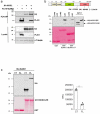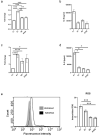The crosstalk between microbial sensors ELMO1 and NOD2 shape intestinal immune responses
- PMID: 36694274
- PMCID: PMC9980453
- DOI: 10.1080/21505594.2023.2171690
The crosstalk between microbial sensors ELMO1 and NOD2 shape intestinal immune responses
Abstract
Microbial sensors play an essential role in maintaining cellular homoeostasis. Our knowledge is limited on how microbial sensing helps in differential immune response and its link to inflammatory diseases. Recently we have confirmed that ELMO1 (Engulfment and Cell Motility Protein-1) present in cytosol is involved in pathogen sensing, engulfment, and intestinal inflammation. Here, we show that ELMO1 interacts with another sensor, NOD2 (Nucleotide-binding oligomerization domain-containing protein 2), that recognizes bacterial cell wall component muramyl dipeptide (MDP). The polymorphism of NOD2 is linked to Crohn's disease (CD) pathogenesis. Interestingly, we found that overexpression of ELMO1 and mutant NOD2 (L1007fs) were not able to clear the CD-associated adherent invasive E. coli (AIEC-LF82). The functional implications of ELMO1-NOD2 interaction in epithelial cells were evaluated by using enteroid-derived monolayers (EDMs) from ELMO1 and NOD2 KO mice. Subsequently we also assessed the immune response in J774 macrophages depleted of either ELMO1 or NOD2 or both. The infection of murine EDMs with AIEC-LF82 showed higher bacterial load in ELMO1-KO, NOD2 KO EDMs, and ELMO1 KO EDMs treated with NOD2 inhibitors. The murine macrophage cells showed that the downregulation of ELMO1 and NOD2 is associated with impaired bacterial clearance that is linked to reduce pro-inflammatory cytokines and reactive oxygen species. Our results indicated that the crosstalk between microbial sensors in enteric infection and inflammatory diseases impacts the fate of the bacterial load and disease pathogenesis.
Keywords: 3D-organoid; AIEC-LF82, epithelial cells and macrophages; ELMO-1; Microbial sensors; NOD2; bacterial engulfment.
Conflict of interest statement
No potential conflict of interest was reported by the authors.
Figures




Similar articles
-
Host engulfment pathway controls inflammation in inflammatory bowel disease.FEBS J. 2020 Sep;287(18):3967-3988. doi: 10.1111/febs.15236. Epub 2020 Feb 20. FEBS J. 2020. PMID: 32003126 Free PMC article.
-
Defects in autophagy favour adherent-invasive Escherichia coli persistence within macrophages leading to increased pro-inflammatory response.Cell Microbiol. 2012 Jun;14(6):791-807. doi: 10.1111/j.1462-5822.2012.01768.x. Epub 2012 Mar 1. Cell Microbiol. 2012. PMID: 22309232
-
The interaction of enteric bacterial effectors with the host engulfment pathway control innate immune responses.Gut Microbes. 2021 Jan-Dec;13(1):1991776. doi: 10.1080/19490976.2021.1991776. Gut Microbes. 2021. PMID: 34719317 Free PMC article.
-
Innate immune sensing of microbes by Nod proteins.Ann N Y Acad Sci. 2006 Aug;1072:19-27. doi: 10.1196/annals.1326.020. Ann N Y Acad Sci. 2006. PMID: 17057187 Review.
-
How NOD2 mutations predispose to Crohn's disease?Microbes Infect. 2007 Apr;9(5):658-63. doi: 10.1016/j.micinf.2007.01.016. Epub 2007 Jan 27. Microbes Infect. 2007. PMID: 17379562 Review.
Cited by
-
Exploring the Effects of Gracilaria lemaneiformis Polysaccharides on the Fecal Microbiota and Fecal Metabolites of Fattening Pigs Based on 16S rDNA and Metabolome Sequencing.Animals (Basel). 2025 Jan 9;15(2):153. doi: 10.3390/ani15020153. Animals (Basel). 2025. PMID: 39858153 Free PMC article.
-
Organoids in gastrointestinal diseases: from bench to clinic.MedComm (2020). 2024 Jun 29;5(7):e574. doi: 10.1002/mco2.574. eCollection 2024 Jul. MedComm (2020). 2024. PMID: 38948115 Free PMC article. Review.
-
eQTL in diseased colon tissue identifies novel target genes associated with IBD.bioRxiv [Preprint]. 2024 Oct 17:2024.10.14.618229. doi: 10.1101/2024.10.14.618229. bioRxiv. 2024. PMID: 39464142 Free PMC article. Preprint.
References
Publication types
MeSH terms
Substances
Grants and funding
LinkOut - more resources
Full Text Sources
Other Literature Sources
Medical
Molecular Biology Databases
Research Materials
Miscellaneous
